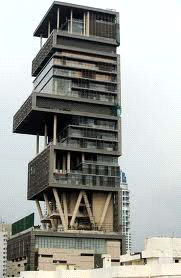Chapter
2.3.6: Antilla,
the Residence of Ambanis
 The building you see on the left is the famous
house of Mr. Mukesh Ambani build at the cost of US $ 1 to 2 BN.
Well, to put things in perspective, that’s something like Rs. 5,000
to 10,000 Crores — I wonder whether a Taj Mahal would cost so much
today. And, see what it looks like: A flatted factory at best and
multi-storey garbage dump at worst. Who can pay so much to build
that? There are two basic ingredients of a good design: Harmony and
Balance. But, both Harmony and Balance are conspicuous by their
absence in the figure on left — even a five year kid wouldn’t
assemble his blocks in such a haphazard manner. In Delhi, there is
an Urban Arts Commission for ensuring that a fantastical arbitrary
mind may not disturb the urban landscape; but, it seems Bombay
doesn’t take its architecture seriously. I really pity the
neighbors, who have to manage with this shabby structure
day-in-and-day-out. Unfortunately, unlike the Ambanis, they can’t
even build helipads on their terraces — though I wonder if it looks
any better from the top.
The building you see on the left is the famous
house of Mr. Mukesh Ambani build at the cost of US $ 1 to 2 BN.
Well, to put things in perspective, that’s something like Rs. 5,000
to 10,000 Crores — I wonder whether a Taj Mahal would cost so much
today. And, see what it looks like: A flatted factory at best and
multi-storey garbage dump at worst. Who can pay so much to build
that? There are two basic ingredients of a good design: Harmony and
Balance. But, both Harmony and Balance are conspicuous by their
absence in the figure on left — even a five year kid wouldn’t
assemble his blocks in such a haphazard manner. In Delhi, there is
an Urban Arts Commission for ensuring that a fantastical arbitrary
mind may not disturb the urban landscape; but, it seems Bombay
doesn’t take its architecture seriously. I really pity the
neighbors, who have to manage with this shabby structure
day-in-and-day-out. Unfortunately, unlike the Ambanis, they can’t
even build helipads on their terraces — though I wonder if it looks
any better from the top.
The most distinctive part of the structure
are the protruding floors in the middle managed by two pillars — I
can well imagine how many mathematical equations would have been
cracked to make this structure stand, but, what if the designers
are neither mathematical genius nor designing stalwarts! The other
distinctive and intriguing feature is the zigzag line, which seems
to have been given a free run, and voila it ran its own
course, sometimes encapsulating five floors, yet, at others, none.
Is this some kind of Feng Shui or Vaastu — thanks goodness,
whatever little architecture I learned, didn’t have any capsules on
Vaastu! Then, there are these “V” for Victory pillars, as if
declaring, “We have the wherewithal to hold even that which lie
above us” — seriously, tough guys, but, do they enjoy doing it;
it’s only going to get tougher with age; WAF…oops…WTF!
If I were to become the Urban Design
Guardian of the Bombay City (assuming such a profile can exist and
survive), I would allow this structure to stand only if it is
immediately converted into a night shelter for the poor — there is
no other way I can allow this injustice to the poor pillars.
©2012-2015 Ankur Mutreja




